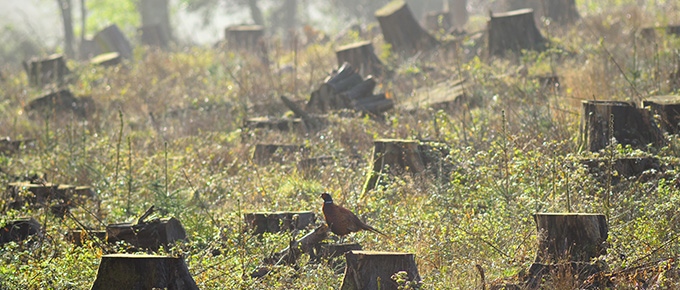Environmental challenges
Ecosystem crisis: Covid-19 at the origin of an (essential) realisation?

SARS, Zika, Ebola…and now Covid-19. While the origin of the new Coronavirus cannot be established with certainty for several years, the link between the deterioration of biodiversity and the emergence of new epidemic infectious diseases is proven. The global pandemic must be a wake-up call; it is time to rethink our development in depth.
The radical disruption of ecosystems
All over the planet, human activity is profoundly changing natural environments. The phenomenon began as early as the 19th century with the first industrial revolution and has accelerated dramatically in recent decades. The massive release of greenhouse gases in particular is causing a major climate crisis1. But another partly related phenomenon is just as worrying: the biodiversity crisis.
While animal and plant species have overcome several crises since the appearance of life on earth, the one we are experiencing is of a radically different nature. A direct consequence of human activity, it is occurring over an extremely short period of time. How can we explain such a situation? “The biodiversity crisis is linked to the way mankind interacts with livingorganismsliving organisms,” analyses Philippe Grandcolas, ecologist, Director of Research at the CNRS and Director of the Institute of “Systematics, Evolution, Biodiversity”. “It is caused in particular by changes in land-use with deforestation, wetland destruction and over-exploitation (fishing, soil depletion, etc.).” Another identifiable reason: “the transport, whether intentional or unintentional, of invasive alien species, which become established in ecosystems that they then disrupt.” The third aggravating factor is the climate crisis itself. And finally, a fourth factor is the increase in extremely harmful pollutants (pesticides, plastics, etc.).
Ocean ecosystems, which cover 70% of the globe, are particularly affected. In concrete terms, “30% of carbon emissions are captured by the ocean,” explains Françoise Gaill, Emeritus Research Director at the CNRS, and Vice-President of the Ocean and Climate platform. “The sharp rise in CO2 emissions changes the chemical balance, causing significant acidification. One of the consequences of this is that it dissolves the skeletal tissue of animals with a shell.” The ocean also captures 90% of the heat emitted by greenhouse gases. When the water temperature rises, the volume increases… This rise in sea levels increased by melting ice is having a significant impact on coastal areas. Similarly, the increase in the number of anoxic sites where the water lacks oxygen is leading to the death of many ecosystems.
The alarming increase of infectious diseases
All these figures are known. The dangers identified are regularly publicised in the media through new reports… before often being put second in our list of priorities. In light of the current health emergency, several world events have had to be postponed. But the news of the last few months could change this, drawing our attention to another dramatic consequence of the ecosystem crisis: its impact on emerging health crises.
Zoonoses, infectious animal diseases that can be transmitted to humans, have always existed but their numbers have increased considerably in less than a century. “We have ten times as many epidemics, four to five times as many new emerging diseases,” says Philippe Grandcolas. “A large proportion of infectious diseases originate from animal species where the infectious agents were residing.” The cause is the conversion of environments: wild animals find themselves living in promiscuity with small groups of humans and their livestock, often in poor sanitary conditions. “Such situations multiply the risks of recombination or evolution of viruses and therefore the risk of crossing species barriers,” the specialist points out. For example, H1N1 is a recombination of the human flu and avian flu viruses, while the first SARS came from bat and carnivore viruses. As for Covid-19, the current hypothesis is that SARS-Cov-2 is the result of a recombination between bat and pangolin viruses.
A time for action
What solutions can be implemented to reduce these risks? The observation is simple: deforestation increases the interfaces between damaged forest environments and populations and therefore increases the danger. “Promiscuity with wild animals, live species taken to market, transport in big cities… All these elements can easily lead to the creation of a pandemic. All this must be reduced,” recommends Philippe Grandcolas. But he also wishes to stress that Asia is not the only area that urgently needs to change its practices. This type of behaviour occurs on all continents, including Europe. “In France, for example, hundreds of thousands of foxes are exterminated every year. In reality, this has never solved the problem of rabies, which has been resolved with a policy of vaccine bait. On the contrary, it leaves rodents, which are a breeding-ground for Lyme disease, more free. “
Beyond these measures, the ecosystem crisis can only be contained by strong cooperation between the key players. Multilateralism may indeed be going through a period of tension, but governments and the private sector have every interest in developing multi-sector horizontal approaches, such as the One Health initiative. This WHO-supported association promotes an integrated, systemic and unified approach to public, animal and environmental health at local, national and global levels. All over the planet, many voices are even calling for a complete paradigm shift. Françoise Gaill underlines that “economic growth is systematically envisaged as “always more”. But when you look at the way any ecosystem works, it’s more S-shaped. There is real growth at one point and then afterwards when these are lasting ecosystems, their growth is minute. We must therefore think not so much in terms of growth but in terms of reorganisation, to do better. It is quality that counts. I believe that any investment must be immersed in a circular economy, but also in a geostrategic (local, state or interstate) economy.”
History unfortunately shows that danger, however serious and imminent it may be, is not enough to push human beings to act. They wait until the danger has begun to affect them directly before they take full measure of it and finally…react. What if that time is now?
